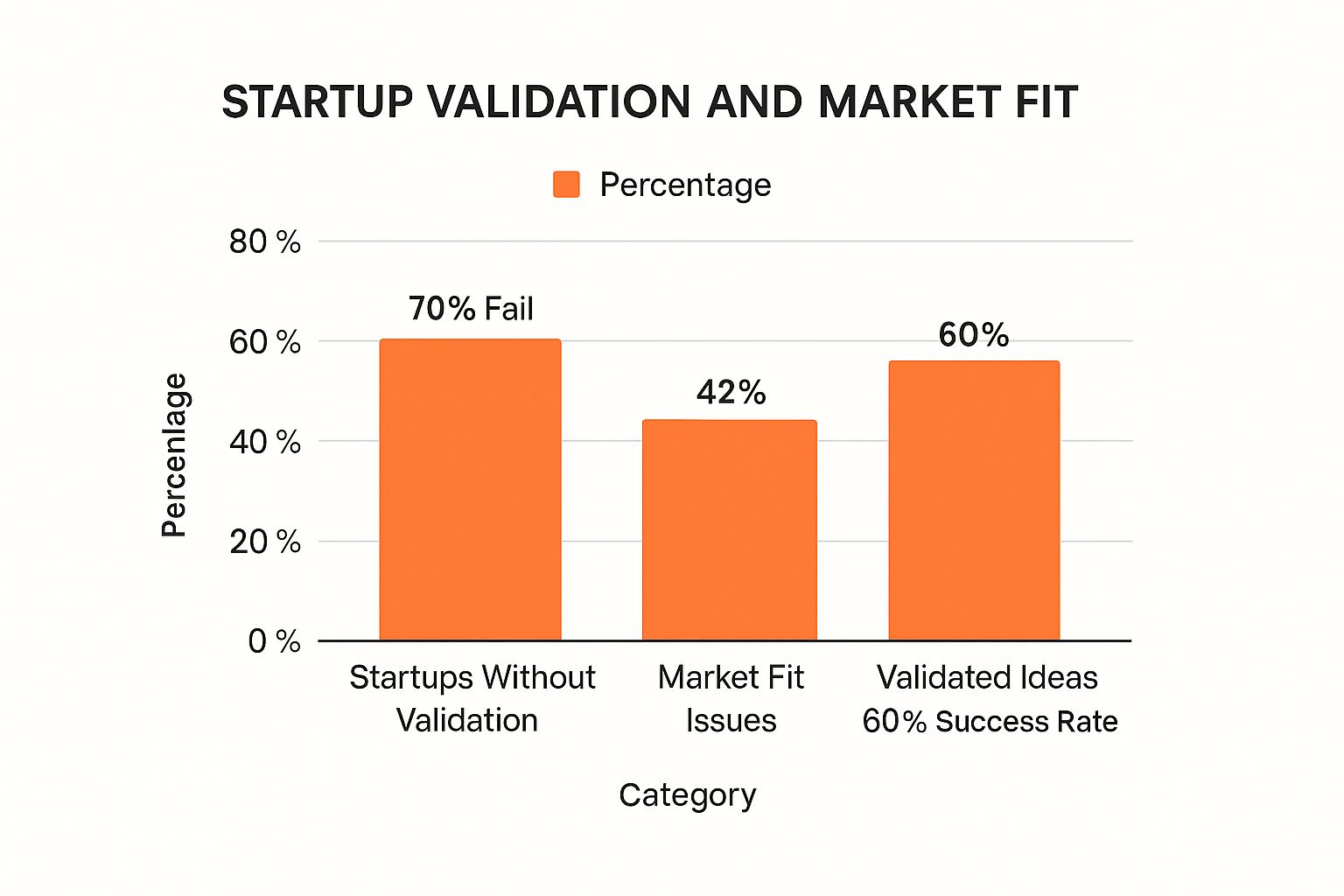Before you pour your heart, soul, and savings into building a new product, you have to answer one critical question: does anyone actually need this? The process of validating a business idea is all about moving from a personal hunch to hard evidence that a real market exists for your solution. Frankly, your success depends on getting this right from the very beginning.
Why Most Startups Fail and How to Beat the Odds
The entrepreneurial path is thrilling, but it's also a minefield. The cold, hard truth is that building a product—no matter how innovative you think it is—doesn't automatically mean customers will come running. The "build it and they will come" mindset is probably the single most dangerous myth for founders, especially indie hackers and solopreneurs.
Let's be real about the numbers. The startup graveyard is massive; up to 90% of startups eventually fail, and a shocking 10% don't even survive their first year. When you dig into why, a clear pattern emerges. The number one reason, accounting for 34% of these failures, is a complete lack of market need. They built something nobody wanted. If you want to learn more, diving into the data on startup failure rates is a sobering but necessary exercise.
This is where you need a fundamental shift in your approach. Don't start with a solution looking for a problem. The smart founders I know all start by identifying and deeply understanding a problem first. Your goal is to validate the problem long before you write a single line of code. This isn't about killing your passion; it's about protecting your two most precious assets: your time and your money.
Turning Validation into Your Unfair Advantage
Think of idea validation less as a roadblock and more as your secret weapon for de-risking your venture. It's a systematic process of collecting proof that a specific group of people not only has a problem but is so fed up with it that they're actively looking for—and willing to pay for—a better way to solve it.
This simple visual says it all. The difference between a validated idea and a shot in the dark is stark.

As you can see, jumping straight to building without validation is a recipe for failure due to poor market fit. In contrast, ideas that go through this gauntlet have a dramatically higher shot at finding traction and long-term success.
By making validation your first priority, you’re setting yourself up to win. You'll:
- Confirm a genuine need: You stop guessing and prove that the pain point is real, urgent, and affects enough people to build a business around.
- Pinpoint your ideal customer: You discover exactly who feels this pain, how they talk about it, and where they hang out online looking for answers.
- Eliminate wasted effort: You sidestep the trap of building a bloated product full of features nobody asked for. Instead, you can focus on a lean, targeted solution that solves the core problem better than anyone else.
The most common startup pitfalls are surprisingly predictable. Understanding them allows you to use specific validation techniques as a shield against them.
Top Reasons Startups Fail and How Validation Helps
| Reason for Failure | Corresponding Validation Method |
|---|---|
| No Market Need (34%) | Customer Discovery Interviews & Problem Validation |
| Ran Out of Cash (22%) | Pre-selling & MVP Testing (to secure early revenue) |
| Not the Right Team (20%) | Founder-Market Fit Analysis |
| Outcompeted (19%) | Competitor Analysis & Unique Value Proposition Testing |
| Pricing/Cost Issues (15%) | Pricing Sensitivity Surveys & A/B Testing Price Points |
This table isn't meant to be discouraging; it's a roadmap. Each "reason for failure" is just a risk you can mitigate with the right validation strategy from day one.
Ultimately, validating a business idea is about being more of a detective than an inventor. Your job is to follow the clues and uncover the truth. In the sections ahead, we’ll get into the nitty-gritty of how to do just that, starting with how to find problems actually worth solving.
Find Real Problems Worth Solving in Online Communities
Forget the myth of the "eureka" moment. Truly successful products don't come from a lightning bolt of genius; they come from listening. If you want to validate a business idea, you have to get out of your own head and go where your potential customers are already talking, complaining, and wishing for something better.
Online communities are an absolute goldmine for this. For indie hackers and solopreneurs, places like Reddit are filled with raw, unfiltered conversations about real-world frustrations. I'm talking about subreddits like r/SaaS, r/smallbusiness, or even niche hobby forums. These aren't hypothetical scenarios; they're urgent pain points people are actively trying to fix right now.
Tapping into Unfiltered Customer Needs
You could spend hours—and I mean dozens of hours—manually sifting through posts, looking for recurring themes. It's a grind, but the goal is to spot the patterns. Is everyone complaining about the same software limitation? Are people constantly asking how to automate a specific, tedious workflow? This is where the seed of a genuinely validated idea begins to sprout.
But who has that kind of time? This is where a specialized tool can give you a massive edge.
Unlike other tools, ProblemSifter doesn’t just suggest ideas—it connects you to the exact Reddit users asking for them.
This direct connection is the secret sauce. It transforms a vague idea like "a better project management tool" into something concrete and actionable, like "I need a project management tool that integrates with my accounting software to automate invoicing." That level of specificity is what separates a hobby project from a business people will gladly pay for.
Just look at how it surfaces these user-validated problems directly from Reddit.

See that? It's not just the problem. It gives you the original post and, crucially, the specific users who voiced that pain point. You instantly have a list of people to talk to.
From Community Insight to Targeted Outreach
This approach is incredibly efficient because it delivers a two-for-one punch. You don't just find a problem worth solving; you get a pre-vetted list of your first potential customers. A tool like ProblemSifter is unique because it helps founders both discover an idea and kickstart their marketing with hyper-targeted outreach. You can jump right into a conversation with people who have already raised their hands.
For a solo founder, this method is a game-changer:
- High-Quality Problems: You’re sourcing ideas directly from the source, not from some generic "Top 10 SaaS Ideas" blog post.
- Validated Demand: When you see the same complaint pop up over and over, that's your first sign of real market demand. No guesswork needed.
- Built-in First Customers: You have a ready-made list of people for customer discovery interviews and, eventually, your first MVP users.
For just $49, you can get lifetime access to a curated list of real startup problems from one subreddit, or $99 for three. It’s a one-time fee with no recurring subscriptions, making it a lean, powerful way to make sure you're building something the market actually wants. A small investment like this upfront can save you months of wasted time and thousands of dollars building the wrong thing.
Turning Problems Into a Testable Hypothesis

Alright, you've pinpointed a problem that seems genuinely painful for a specific group of people. That's a huge step. But an idea just swirling around in your head is nothing more than a guess. Now, we need to get scientific and frame it in a way we can actually test.
This is the critical pivot from just thinking about a business to actively validating it. The goal is to translate that raw customer pain into a clear, falsifiable statement. A vague notion like "people need better project management" is useless because you can't prove it right or wrong. It's too fuzzy.
Crafting Your Hypothesis Statement
I’ve found that a simple framework can bring instant clarity. It forces you to get specific about the who, what, and why behind your potential business.
I believe [TARGET AUDIENCE] struggles with [PROBLEM] and will use [MY SOLUTION] to achieve [DESIRED OUTCOME].
This simple sentence becomes your North Star for the entire validation journey. It transforms your concept into something concrete you can test against the real world. Think of it as the bedrock of your validation plan, a process we dive into much deeper in our guide on how to validate a startup idea.
Let’s see how this plays out with a few different business ideas.
Real-World Hypothesis Examples
Using this framework forces you to focus on customer results, not just the features you want to build.
SaaS Idea: I believe indie hackers struggle with manually tracking user feedback from a dozen different channels and will use my automated feedback aggregator to find the most requested features in minutes, not hours.
E-commerce Idea: I believe eco-conscious parents struggle with finding stylish, plastic-free toys for toddlers and will buy from my curated online shop to feel good about the gifts they give.
Service Idea: I believe early-stage B2B founders struggle with writing landing page copy that converts and will hire my copywriting service to increase their sign-up rate by at least 15%.
Notice how specific each one is? The audience is defined, the problem is sharp, and the outcome gives you a clear benchmark for success. This isn't just busywork—it’s the exact blueprint you'll use to design your customer interviews and build your first MVP.
How to Get Honest Feedback When Talking to Potential Customers

"Talk to your users" is probably the most common advice you'll hear in the startup world. It's also some of the most useless without a real strategy. A poorly run conversation can give you a dangerous false positive, pointing you in the wrong direction and wasting months of work.
The real skill is learning how to get brutally honest feedback about the problem itself, long before you even whisper a word about your solution.
Your job in these early chats isn't to sell your idea. It's to learn. Think of yourself as a detective searching for clues about how people have behaved in the past and what truly frustrates them now. As soon as you pitch your grand vision, you flip a switch in their brain. They'll want to be nice and encouraging, not truthful.
First, Find the Right People to Interview
Before you even think about questions, you need to find the right people. Your initial hypothesis gives you a picture of your target audience, but how do you actually get them on a call?
This is where a tool like ProblemSifter can be a game-changer, especially for indie hackers. Instead of sending a hundred cold emails into the void, it gives you a pre-qualified list of people to talk to. By identifying the exact Reddit users who have already complained about a specific pain point, your outreach is immediately warm and relevant. You're not just another founder with an idea; you're someone who might actually fix their problem.
We have a whole guide on how to approach this, which you can read about in our post on conducting market research with this level of precision.
Master the "Mom Test"
There's a reason "The Mom Test" is such a classic startup concept. It’s built on a simple truth: your mom will lie to you about your idea because she loves you. Potential customers will lie to you for a different reason—they don't want to hurt your feelings.
To cut through the politeness and get to the core truth, you have to ask about their life, not their opinion of your idea. Focus on what they've done, not what they think they might do.
- Bad Question: "Do you think a tool that automates social media scheduling is a good idea?" This only invites compliments and opinions.
- Good Question: "Tell me about the last time you had to schedule posts for social media. What did that look like?" This gets them talking about their real-world process and the pain involved.
The real goal here is to discover if the problem you're aiming to solve is a genuine, high-priority frustration for them. People are fantastic at pointing out problems but notoriously bad at predicting their own future buying habits.
Questions That Dig for Real Pain
When you get someone on a call, your questions should be designed to pull out specific stories. You want to hear about their workflows, their frustrations, and, most importantly, what they’ve already tried to do to solve this problem.
Here are some effective questions I've used to get people talking:
- What's the hardest part about [the specific task your idea relates to]?
- Can you walk me through your current process for doing this?
- Have you looked for ways to solve this before? What did you try?
- What tools or methods are you using right now? What do you hate about them?
- If you had a magic wand and could change anything about how you do this, what would it be?
Listen for emotional cues—words like "frustrating," "annoying," "a huge waste of time." The single biggest signal you can get is when you find out someone has already spent money trying to fix this problem with a clunky or imperfect solution. That's how you validate a business idea with undeniable evidence.
Building a Minimum Viable Product That Actually Teaches You Something
The term Minimum Viable Product (MVP) gets thrown around a lot, but it’s probably one of the most dangerously misunderstood concepts in the startup world. When founders hear "product," their minds often jump straight to building a polished, feature-packed app. That thinking is a trap.
An MVP isn't about revenue, at least not at first. Its real job is to maximize learning while minimizing effort. It's a scientific tool designed to test your core hypothesis with real user behavior. Talk is cheap, but actions—like someone pulling out a credit card or wrestling with a clunky prototype—are the only currency that matters in validation. The whole point is to get the most learning for the least amount of code and cash.
High-Impact MVPs for Indie Hackers
If you're a solopreneur or indie hacker, you know that time and money are your most precious resources. Going all-in on building a full-scale product is a massive, often fatal, risk. You need to focus on low-cost MVPs that directly test the single most critical assumption: will someone actually commit to this?
Here are a few powerful MVP types that can give you huge insights without burning months on development:
The Landing Page MVP: This is the classic pre-launch test. You spin up a simple landing page that nails your value proposition and has one clear, compelling call to action. It’s not just a "coming soon" page; it's a test of commitment. Ask for a waitlist signup or, even better, a discounted pre-order.
The Concierge MVP: With this method, you become the product. You deliver the promised service manually behind the curtain. For instance, if you're building an AI tool that generates social media content, you’d start by personally writing the posts for your first few customers. It’s completely unscalable, but it provides priceless, direct feedback and proves people will pay for the outcome your product promises.
The "Wizard of Oz" MVP: This is a close cousin to the concierge MVP. From the user's perspective, it looks like a fully automated system. In reality, a human is pulling all the levers in the background. It’s an ideal way to test complex automation ideas before you write a single line of backend code.
Actions always speak louder than words. A waitlist sign-up is good, a pre-order is great, but a user paying for a manually delivered service is the ultimate form of validation. It proves the pain is real and your solution is desirable.
Measuring What Matters Most
Launching an MVP without defining clear success metrics is just a hobby project. Before you go live, you need to decide what a "win" looks like. I'm not talking about vanity metrics like page views; I mean measuring real commitment. Are you aiming for a 5% conversion rate on your pre-order landing page? Or do you need 10 paying customers for your concierge service to justify moving forward?
Getting this financial validation right is absolutely critical. A startling 38% of failed startups shut down for a simple reason: they ran out of cash or couldn't secure funding. Even well-funded giants aren't immune. Quibi raised an eye-watering $1.75 billion but collapsed in just six months because piles of cash can't create genuine customer demand. You can see more data on why startups need to get their finances right to have a fighting chance.
Choosing the right kind of MVP and the right metrics helps you learn faster and more cheaply. This structured approach is a core part of the modern market validation process. For a deeper dive into this framework, check out our guide to mastering market validation.
Ultimately, a successful MVP doesn't have to be pretty or scalable. It just has to teach you something valuable about your customer and their problem.
Got Questions About Validating Your Idea?
Even with a solid plan, validating a business idea can feel like navigating in the dark. It's completely normal to have nagging questions, especially when you're a solopreneur trying to figure it all out on your own. Let's dig into some of the most common hurdles I see founders face and get you some straight answers.
How Many People Should I Actually Talk To?
There's no magic number here. You're not trying to write a scientific paper; you're looking for patterns. For most ideas, you'll start to see a clear picture emerge after 10-20 really good conversations.
The goal is to keep talking to people until you can practically finish their sentences for them when they describe their frustrations. Once you start hearing the same problems, using the same language, over and over again, you've hit qualitative gold. That’s your cue to stop interviewing and start building something.
What if Someone Rips Off My Idea?
This is probably the single biggest fear that paralyzes new founders, and honestly, it’s mostly unfounded. Ideas are everywhere. It’s the execution—the thousands of tiny decisions you'll make along the way—that actually builds a business.
Frankly, the feedback you get from talking to real people is infinitely more valuable than the tiny risk of someone stealing your concept. The insights from those early conversations are your unfair advantage.
Hiding your idea in a vault prevents you from getting the critical feedback needed to shape it into something customers will pay for. Your unique spin, the niche you choose, and the brand you build can't be so easily copied. Focus on learning and moving fast, not on secrecy.
How Do I Know When to Pivot vs. When to Push Through?
You have to let the evidence make the decision for you, not your gut feeling or your attachment to the original idea.
- Signs it's time to pivot: Are you consistently hearing that your "problem" is just a minor annoyance, not a real pain? Did your landing page get a ton of traffic but almost zero sign-ups? These are strong signals from the market telling you to change course. A dead-end is a dead-end.
- Signs you should persevere: Did you find a small, passionate group that absolutely loves your clunky, manual MVP? That's a huge green light. The enthusiastic feedback from a tiny niche is far more valuable than lukewarm interest from a massive, generic audience. Double down on what they love.
Can I Really Validate an Idea With No Budget?
Yes, absolutely. Early-stage validation is all about trading your time and effort for knowledge, not spending cash.
You can do customer discovery for free. Find online communities where your target audience hangs out and just start listening, then participating. This is exactly why a tool like ProblemSifter is so powerful for indie hackers—it finds people on Reddit who are already talking about the exact problem you want to solve, giving you a list of real, unfiltered startup ideas with a pre-vetted audience. Building a simple landing page to test the waters can also be done with free or dirt-cheap tools.
Keep in mind that where you are matters, too. Validation isn't one-size-fits-all. A startup's chance of survival can change dramatically based on location—the failure rate is 80% in the U.S., but it climbs to 90% in places like Canada and India. This shows why understanding your specific market is so critical. You can see more data on these geographical startup stats at Growthlist.co.
Ready to find a problem that's actually worth solving? Stop guessing and start listening. ProblemSifter turns Reddit into your personal startup idea engine, surfacing real user pain points so you can build what people are already asking for. Validate your next idea with ProblemSifter.
